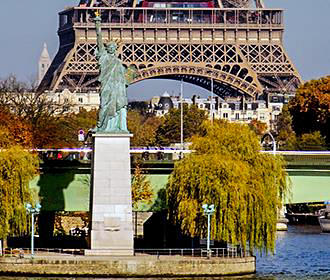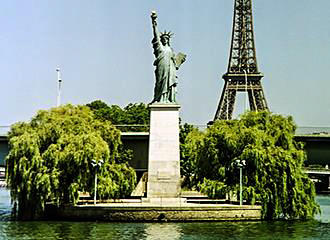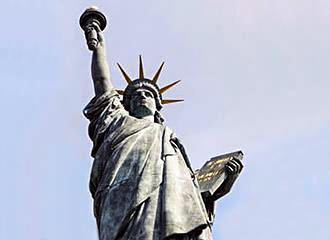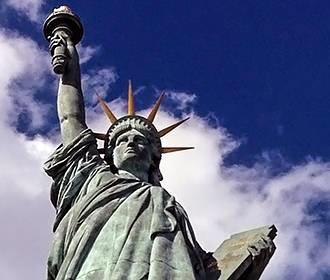Paris Statue of Liberty on Ile aux Cygnes
Even though people think of the Statue of Liberty being located in America, you will find that there are in fact replica statues in Paris and in many other countries, but in fact, the original was designed and constructed by the French.
A bit of history
In French it is known as the Statue de la Liberte and it all came about due to the relations between America and France, and a French sculptor by the name of Frederic Auguste Bartholdi who was inspired to create a monument after discussions with a gentleman called Edouard Rene de Laboulaye.
It was in the June of 1871 that Frederic Auguste Bartholdi crossed the Atlantic Ocean and put his proposal of a national monument forward, along with his suggestion of this being located at the New York harbour entrance.
Upon his return to Paris, with the ideas of constructing a statue to represent Libertas, the Goddess of Freedom, adorned in robes and holding a torch to symbolise peace, he began producing numerous drawings and models.
Bartholdi managed to interest a renowned architect by the name of Eugene Viollet-le-Duc, who drew up plans for a brick pier for the statue to be anchored, and in 1875 the project was announced as a Franco-American union.
He initially produced a plaster model, which was donated to the Musee des Arts et Metiers Museum in Paris by his widow, and then Bartholdi produced a bronze Paris Statue of Liberty, which was to be put in place on the Ile aux Cygnes in 1885.
Frederic Auguste Bartholdi eventually donated another bronze model of the Statue of Liberty to the Musee du Luxembourg in 1900, which was placed within the Luxembourg Gardens, although this is now a replica and the original is held within the Musee d'Orsay for preservation. However we are getting ahead of ourselves here.
The main construction of the first part of the colossal Statue of Liberty, being the head and the right arm holding the torch, were being produced at a workshop near Paris, and the head itself was put on display at the World Fair in Paris in 1878. But the arm and torch were meant to be presented at an exhibition in America, yet never reached their destination in time.
Fundraising to pay for the statue had been put in place, which meant that the constructions could go a little smoother and quicker, but unfortunately, when Viollet-le-Duc died, Frederic Auguste Bartholdi had to enrol a new engineer to design the tower that would support the Statue of Liberty.
The innovative engineer chosen was Gustave Eiffel, whose name you may recognise, as it was this gentleman who designed the famous landmark of the Eiffel Tower in Paris.
Having been constructed completely in France and finished in 1884, then disassembled, shipped across the ocean and reassembled on site, the Statue of Liberty at New York Harbour was officially inaugurated in 1886.
The Paris Statue of Liberty
You will actually find more than one Paris Statue of Liberty, and the first is a bronze that the French sculptor Frederic Auguste Batholdi produced as a scale model of the original located in the United States of America.
This is now located at the Musee d’Orsay with a copy in the Luxembourg Gardens, which is where the original once stood. However, there are also different sculptures, miniatures, etc within the Musee des Arts et Metiers, along with an original plaster model as well.
But the main Statue of Liberty, or Statue de la Liberte as it is known in French, is located on the Ile aux Cygnes on the tip of the island within the River Seine, right by the Pont de Grenelle bridge.
This bronze Paris statue was officially inaugurated in 1889, yet its creator absolutely hated the fact that it was facing to the east, and therefore turning her back on America, which was not the purpose of the statue, and definitely not the intentions to keep relations between France and America.
However, it was only for the Universal exhibition of 1937 when places such as Palais de Chaillot were constructed, that the statue was actually moved to its current position, as though it is facing towards America, just as it was first intended.
Also, there is also Flame of Liberty, called the Flamme de Liberte in French, that was donated by America to France, which is an exact copy of the flame in scale to the one in New York. And this is located by the Pont d’Alma bridge, but has also become an unofficial monument to Princess Diana, after she died in a car crash near here.
Visiting the Paris Statue of Liberty on Ile aux Cygnes
We have already mentioned where other liberty statues in Paris are located, so we will concentrate on the main one, which is the Paris Statue of Liberty on Ile aux Cygnes island in the middle of the River Seine.
This is actually found at the opposite end of the island to the Pont Bir-Hakeim and the France Renaissante statue, and is situated on a platform with a walkway from the Pont de Grenelle bridge, which can be accessed from the 15th or 16th Arrondissements.
When it comes to Paris public transport, the nearest Metro stations are the Javel - Andre Citroen stop by the Pont Mirabeau and the Charles Michels stop both serving line 10, yet in the opposite direction you have the Bir-Hakeim stop serving line 6.
If you are travelling via train, then the nearest RER train stations are called the Gare d'Avenue du Pdt Kennedy stop or the Javel stop both serving the RER C line or upstream a little further heading towards the Eiffel Tower you have the Champ de Mars - Tour Eiffel stop also serving the RER C line.
Alternatively if you travelling via bus then the nearest bus stops serve line 70 along with the Noctilien Night Bus Service via lines N12 and N61. However, downstream there are the lines 62, 72 and 88 but in an easterly direction by the Charles Michels Metro you have the bus line 42 as well as some of the others mentioned previously.



